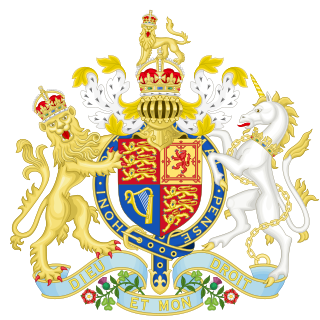
Caroline of Brunswick-Wolfenbüttel was Queen of the United Kingdom of Great Britain and Ireland and Queen of Hanover from 29 January 1820 until her death in 1821 as the estranged wife of King George IV. She was Princess of Wales from 1795 to 1820.

Fulham is an area of the London Borough of Hammersmith & Fulham in West London, England, 3.6 miles (5.8 km) southwest of Charing Cross. It lies on the north bank of the River Thames, bordering Hammersmith, Kensington and Chelsea. The area faces Wandsworth, Putney, Barn Elms and the London Wetland Centre in Barnes. on the far side of the river.

Hammersmith is a district of West London, England, 4.3 miles (6.9 km) southwest of Charing Cross. It is the administrative centre of the London Borough of Hammersmith and Fulham, and identified in the London Plan as one of 35 major centres in Greater London.

Robert Banks Jenkinson, 2nd Earl of Liverpool, was a British Tory statesman who served as Prime Minister of the United Kingdom from 1812 to 1827. He also held many other important cabinet offices such as Foreign Secretary, Home Secretary and Secretary of State for War and the Colonies. He was also a member of the House of Lords and served as leader.

Sir George Hayter was an English painter, specialising in portraits and large works involving sometimes several hundred individual portraits. Queen Victoria appreciated his merits and appointed Hayter her Principal Painter in Ordinary and also awarded him a Knighthood in 1841.

Caroline Elizabeth Sarah Norton, Lady Stirling-Maxwell was an active English social reformer and author. She left her husband, who was accused by many of coercive behaviour, in 1836. Her husband then sued her close friend Lord Melbourne, then the Whig Prime Minister, for criminal conversation (adultery).

The Pains and Penalties Bill 1820 was a bill introduced to the British Parliament in 1820, at the request of King George IV, which aimed to dissolve his marriage to Caroline of Brunswick, and deprive her of the title of queen.
Queen Caroline may refer to:

West Kensington, formerly North End, is an area in the ancient parish of Fulham, in the London Borough of Hammersmith and Fulham, England, 3.4 miles (5.5 km) west of Charing Cross. It covers most of the London postal area of W14, including the area around Barons Court tube station, and is defined as the area between Lillie Road and Hammersmith Road to the west, Fulham Palace Road to the south, Hammersmith to the north and West Brompton and Earl's Court to the east. The area is bisected by the major London artery the A4, locally known as the Talgarth Road. Its main local thoroughfare is the North End Road.

Augusta of Great Britain was a British princess, granddaughter of George II and the only elder sibling of George III. She was Duchess of Brunswick-Lüneburg and Princess of Brunswick-Wolfenbüttel by marriage to Charles William Ferdinand, Duke of Brunswick. Her daughter Caroline was the spouse of George IV.

Margaret Hughes, also Peg Hughes or Margaret Hewes, was an English actress who is often credited as the first professional actress on the English stage, as a result of her appearance on 8 December 1660. Hughes was the mistress of the English Civil War general Prince Rupert of the Rhine.
The Honourable Richard Keppel Craven was a British nobleman, traveller and author.

Elizabeth, Princess Berkeley, sometimes unofficially styled Margravine of Brandenburg-Ansbach, previously Elizabeth Craven, Baroness Craven, was an author and playwright, perhaps best known for her travelogues.

Christian Friedrich Carl Alexander was the last margrave of the two Franconian principalities, Bayreuth and Ansbach, which he sold to the King of Prussia, a fellow member of the House of Hohenzollern.

Elizabeth Conyngham, Marchioness Conyngham, was an English courtier and noblewoman. She is thought to be the last mistress of George IV of the United Kingdom.

Princess Friederike Luise of Prussia was a daughter of Frederick William I of Prussia and Sophia Dorothea of Hanover and Margravine of Brandenburg-Ansbach.

Sir Nicholas Crispe, 1st Baronet was an English Royalist and a wealthy merchant who pioneered the West African slave trade in the 1630s; a customs farmer ; Member of Parliament for Winchelsea Nov. 1640-1 ; member of the Council of Trade and for Foreign Plantations ; and Gentleman of the Privy Chamber from 1664. He was knighted in 1640 or 1641 and was made a baronet in 1665. He died in February 1666 (O.S.) aged 67.

Montagu House was a prominent residence situated near to the southwest corner of Greenwich Park, overlooking the common at Blackheath in what is today southeast London. Adjacent to the Ranger's House, it was the royal residence of Caroline of Brunswick before being demolished in 1815.

Louisa Theodosia Jenkinson, Countess of Liverpool was a British noblewoman and the first wife of Robert Jenkinson, 2nd Earl of Liverpool, who served as prime minister from 1812 to 1827.

















